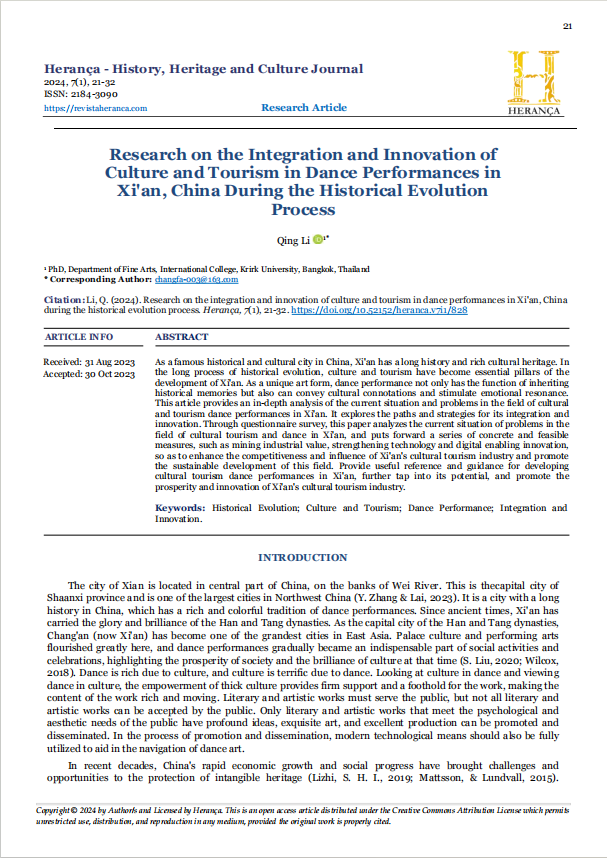Research on the Integration and Innovation of Culture and Tourism in Dance Performances in Xi'an, China During the Historical Evolution Process
DOI:
https://doi.org/10.52152/heranca.v7i1.828Palavras-chave:
Historical Evolution, Culture and Tourism, Dance Performance, Integration and InnovationResumo
As a famous historical and cultural city in China, Xi'an has a long history and rich cultural heritage. In the long process of historical evolution, culture and tourism have become essential pillars of the development of Xi'an. As a unique art form, dance performance not only has the function of inheriting historical memories but also can convey cultural connotations and stimulate emotional resonance. This article provides an in-depth analysis of the current situation and problems in the field of cultural and tourism dance performances in Xi'an. It explores the paths and strategies for its integration and innovation. Through questionnaire survey, this paper analyzes the current situation of problems in the field of cultural tourism and dance in Xi'an, and puts forward a series of concrete and feasible measures, such as mining industrial value, strengthening technology and digital enabling innovation, so as to enhance the competitiveness and influence of Xi'an's cultural tourism industry and promote the sustainable development of this field. Provide useful reference and guidance for developing cultural tourism dance performances in Xi'an, further tap into its potential, and promote the prosperity and innovation of Xi'an's cultural tourism industry.
Downloads
Referências
Bai, H. T. (2017). Explore the aesthetic characteristics of Chinese traditional dance. Art and Technology, 6, 84-89.
Bu, Y. (2019). The Chinese folk dance on the silk road during High Tang Dynasty period. Дипломатически, икономически и културни отношения между Китай и страните от Централна и Източна Европа, 4(1), 164-175.
Chen, P. (2018). On traditional Chinese culture: common rhythmical point between traditional opera and classical dance. In 2018 Symposium on Health and Education (SOHE 2018) (pp. 44-48). Atlantis Press.
Dilanchiev, A., Aghayev, A., Rahman, M. H., Ferdaus, J., & Baghirli, A. (2021). Dynamic analysis for measuring the impact of remittance inflows on inflation: evidence from Georgia. International Journal of Financial Research, 12(1), 339-347.
Gerdes, E., & Lin, Y. (2022). Toward demarginalization: navigating Chinese dance and movement in US higher education. Journal of Dance Education, 1-11.
Guo, B. (2023). The impact of free trade zone construction (FTZs) on food security under the "Belt and Road" strategy and influencing e-commerce and technological innovation. Journal of Information Systems Engineering and Management, 8(2), 21645.
Hsu, C. H., & Huang, S. S. (2016). Reconfiguring Chinese cultural values and their tourism implications. Tourism Management, 54, 230-242.
Lin, C., & Liu, C. (2023). Intercultural aesthetics in traditional Chinese dance performance. International Review of the Aesthetics and Sociology of Music, 54(1), 129-146.
Liu, S. (2020). The Chinese dance: a mirror of cultural representations. Research in Dance Education, 21(2), 153-168.
Lizhi, S. H. I. (2019). Significance of protection and publicity of Chinese cultural heritage. Cross-Cultural Communication, 15(3), 36-39.
Mattsson, T., & Lundvall, S. (2015). The position of dance in physical education. Sport, Education and Society, 20(7), 855-871.
Mohsin, M., Nurunnabi, M., Zhang, J., Sun, H., Iqbal, N., Iram, R., & Abbas, Q. (2021). The evaluation of efficiency and value addition of IFRS endorsement towards earnings timeliness disclosure. International Journal of Finance & Economics, 26(2), 1793-1807.
Mohsin, M., Taghizadeh-Hesary, F., Iqbal, N., & Saydaliev, H. B. (2022). The role of technological progress and renewable energy deployment in green economic growth. Renewable Energy, 190, 777-787.
Pu, L. (2018). Explore the aesthetic characteristics of Chinese traditional dance. Tomorrow Fashion, 2018(6), 23-26.
Szadziewski, H., Mostafanezhad, M., & Murton, G. (2022). Territorialization on tour: The tourist gaze along the Silk Road economic belt in Kashgar, China. Geoforum, 128, 135-147.
Ullah, K., Rashid, I., Afzal, H., Iqbal, M. M. W., Bangash, Y. A., & Abbas, H. (2020). SS7 vulnerabilities—a survey and implementation of machine learning vs rule based filtering for detection of SS7 network attacks. IEEE Communications Surveys & Tutorials, 22(2), 1337-1371.
Vanama, P. K. (2018). Tridimensional Telangana folk dance forms: An innovative insight towards sustaining cultural tourism. International Journal of Culture and Tourism Research, 11(1), 14-20.
Wilcox, E. (2019). Revolutionary bodies: Chinese dance and the socialist legacy (p. 324). University of California Press.
Wilcox, E. E. (2018). Dynamic inheritance: Representative works and the authoring of tradition in Chinese dance. Journal of Folklore Research, 55(1), 77-111.
Wu, Q., Yan, D., & Umair, M. (2023). Assessing the role of competitive intelligence and practices of dynamic capabilities in business accommodation of SMEs. Economic Analysis and Policy, 77, 1103-1114.
Xi, X. Z., Zheng, W., & Umair, M. (2022). Testing the fluctuations of oil resource price volatility: a hurdle for economic recovery. Resources Policy, 79, 102982.
Yin, Z. (2015). Research on the teaching innovation of Chinese folk dance. In 2015 International Conference on Management, Education, Information and Control. Shenyang, China. Atlantis Press.
Yue, N. (2017). A brief discussion on the technical skill difference between chinese classical dance and western dance. In 2017 International Conference on Humanities Science, Management and Education Technology (HSMET 2017) (pp. 334-337). Atlantis Press.
Zhao, J. (2017). Zhong guo chuan tong wu dao de shen mei te zheng [Aesthetic characteristics of Chinese traditional dance]. Voice of the Yellow River, (21), 41-43.
Zhao, X., Xie, C., Huang, L., Wang, Y., & Han, T. (2023). How digitalization promotes the sustainable integration of culture and tourism for economic recovery. Economic Analysis and Policy, 77, 988-1000.
Zhang, C., & Zhu, M. (2020). The integration of culture and tourism: multi-understandings, various challenges and approaches. Tourism Tribune, 35(3), 62-71.
Zhang, Y. & Lai, C. G. (2023). Impact of Social Network Sites on Developing Brand Communication in Xian City. International Journal of Communication Networks and Information Security (IJCNIS), 15(3), 261–272.
Zhu, Y. (2015). Cultural effects of authenticity: Contested heritage practices in China. International Journal of Heritage Studies, 21(6), 594-608.

Downloads
Publicado
Como Citar
Edição
Secção
Licença
Direitos de Autor (c) 2023 Herança - Revista de História, Património e Cultura

Este trabalho encontra-se publicado com a Licença Internacional Creative Commons Atribuição 4.0.






8.png)





